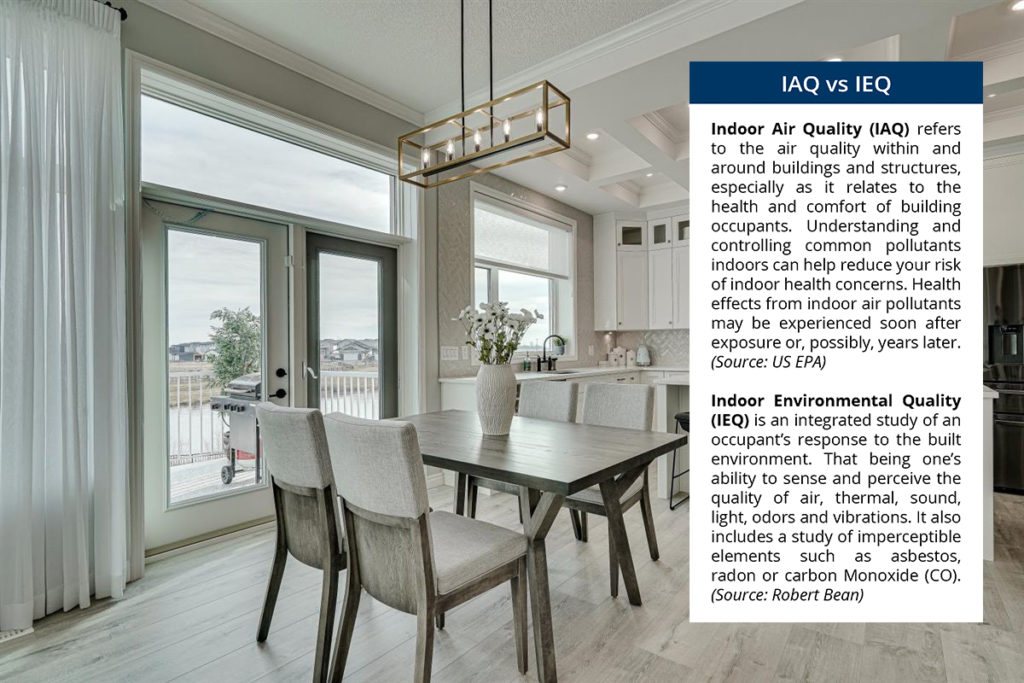Good Indoor Air Quality (IAQ) and Indoor Environmental Quality (IEQ) are both key to a healthier and more comfortable living experience. On top of being far more energy efficient than conventional homes, Net Zero Homes provide exceptional IAQ and IEQ for greater wellness and comfort. In this post, we break down why Net Zero Homes are healthier and more comfortable to live in.

“Net Zero Home in Martensville” by North Ridge Development Corporation in Saskatoon, SK – Finalist for the Net Zero Home Award in the 2021 CHBA National Awards for Housing Excellence
Why does indoor air quality matter?
Canadians spend approximately 90% of their time indoors. And the pandemic resulted in more people working and learning from home – a trend that is likely to continue for some. The increased time spent at home means that good IAQ and IEQ are especially important for healthier, more comfortable living. Studies by Health Canada and the Canadian Mortgage and Housing Corporation (CMHC) show that IAQ is a key part of personal health management, comfort, and productivity.
Historic changes in construction and renovation in Canada – like the installation of air conditioners and exhaust fans – reduced how often occupants needed to open their windows. With those changes came the need for the homes’ mechanical systems to compensate for the lack of natural ventilation.

Net Zero Home by Terra View Custom Homes Ltd. in Guelph, ON
How are Net Zero Homes healthier and more comfortable?
Net Zero Homes are healthier and more comfortable because they are purposefully built to achieve exceptional IAQ and IEQ. IEQ extends beyond just air quality. It refers to how the occupant of the home senses and perceives the quality of sound, light, odours, temperature, humidity, and even vibrations within the home.
Net Zero Homes offer highly insulated and airtight building envelopes (exterior walls, ceiling and foundation) with high-performance windows, virtually silencing outdoor noise, such as traffic, lawnmowers and barking dogs. These “warm” walls, floors and windows also offer greater thermal comfort as experienced through the temperature radiating from these surfaces. Net Zero Homes also feature superior heating, cooling and balanced ventilation equipment, which means even temperatures (and improved humidity control) throughout the home all year round.
How do Qualified Net Zero Builders and Renovators create healthy homes?
Qualified Net Zero Builders and Renovators employ advanced building science strategies that work to achieve improved IAQ, providing an exceptional living environment in each of their Net Zero Homes. Here are a few key strategies that are used for a home to be labelled under CHBA’s Net Zero Home Labelling Program:
1) Source Control
Net Zero Homes are very airtight to help keep outdoor pollutants and allergens out of the home. CHBA’s Net Zero Home Labelling Program requires each home to have an airtightness test to verify air leakage levels. Completed by a third-party Energy Advisor (EA), the airtightness test requires the use of a blower door, which is an instrument that depressurizes the home and measures the air leakage over time. Net Zero Homes must achieve an airtightness of 1.5 air changes per hour (ACH) or better. By comparison, a home built in the 1980’s would have an airtightness of 10+ ACH, while a code-built home in 2020 tests at about 3 ACH on average.
2) Ventilation & Filtration
Qualified Net Zero Builders and Renovators use the mantra “build tight and ventilate right,” when building or renovating Net Zero Homes. Since Net Zero Homes are so airtight, with minimal air leaking through the building envelope, advanced mechanical ventilation systems called Heat Recovery Ventilators (HRV) or Energy Recovery Ventilators (ERV) must be installed to provide occupants with fresh air at all times. An HRV/ERV acts as the lungs of the home, circulating fresh air in and bad air out. This balanced ventilation helps improve indoor air quality by diluting pollutant and moisture levels that may result in poor occupant comfort and/or adverse health effects. The HRV/ERV also filters the incoming fresh air to reduce allergens and asthma triggers, such as dust, pollen and outdoor air pollution.


“One Raven Net Zero” infill duplex by Naikoon Contracting Ltd. in Vancouver, BC – Finalist for the Net Zero Home Award in the 2021 CHBA National Awards for Housing Excellence
What can you do to improve the indoor air quality in your home?
There are several things you can also do to help protect your indoor air from outdoor pollutants, as well as from indoor pollutants. Making sure your mechanical systems are well maintained, including changing/cleaning the filters is very important. You should also use exhaust fans in the bathrooms when showering or bathing to reduce humidity and prevent mould growth. Use your range hood to reduce your exposure to pollutants from your cooking activities. There are many more great suggestions included in the links provided throughout this blog post. The decisions that you make can also significantly impact your health and comfort.
Net Zero Homes: exceptional energy performance and the ultimate in comfort – a home at the forefront of sustainability. It all adds up to a better living experience. Learn more about Net Zero Homes at netzerohome.com.
Choose a builder/renovator who is knowledgeable of both IAQ and IEQ – choose a CHBA Qualified Net Zero Builder/Renovator! Find a Qualified Net Zero Builder or Renovator in your area via our CHBA Net Zero directory.
